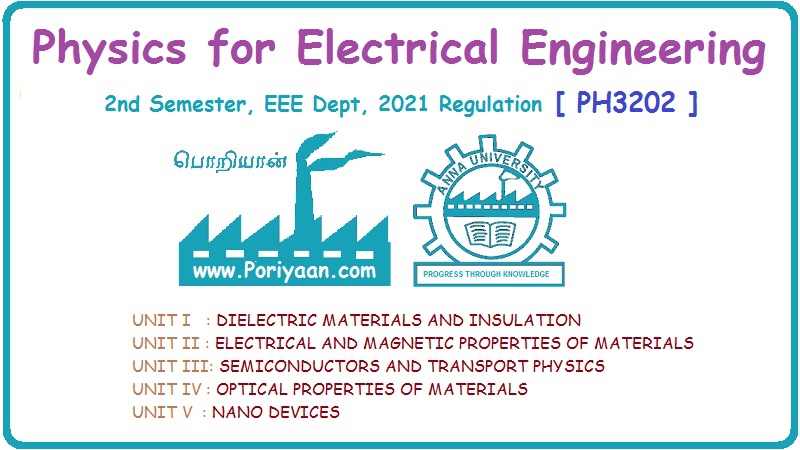Physics for Electrical Engineering: Unit V: Nano Devices
Part A - 2 Marks Questions and Answer
Nano Devices | Physics for Electrical Engineering
Physics for Electrical Engineering: Unit V: Nano Devices : Part A '2' Marks Q and A
Part A '2' Marks Q & A
1.
Define nano materials.
Nanophase
materials are newly developed materials with grain size at the nanometre range
(10-9 m), i.e., in the order of 1 100 nm. The particle size in a
nano material is 1 - 100 nm.
2.
Define density of states.
It
is defined as the number of available electron states per unit volume in an
energy interval E and E + dE. It is denoted by Z (E).
3.
Define Fermi energy.
It
is defined as the highest energy level occupied by the electron at OK in metal.
4.
What is a quantum confinement?
It
is a process of reduction of the size of the solid such that the energy levels
inside become discrete.
5.
What is quantum structure?
When
a bulk material is reduced in its size, atleast one of its dimension, in the
order of few nanometres, then the structure is known as quantum structure.
6.
What is quantum size-effect?
When
the size of a nanocrystal becomes smaller than the deBroglie wavelength,
electrons and holes get spatially confined, electrical dipoles get generated,
the discrete energy levels are formed.
As
the size of the material decreases, the energy separation between adjacent
levels increases. The density of states of nanocrystals is positioned in
between discrete (as that of atoms and molecules) and continuous (as in
crystals).
Quantum
size effect is most significant for semiconductor nanoparticles.
7.
What is single electron phenomena?
Present
day, transistors require 10,000 electrons. Rather than moving many electrons
through transistors, it may very well be practical and necessary to move
electrons one at a time. The phenomena in known as single electron phenomena.
8.
Define Coulomb - Blockade effect.
The
charging effect which blocks the injection or rejection of a single charge into
or from a quantum dot is called Coulomb blockade effect.
9.
What is single electron tunneling?
The
quantization of charge can dominate and tunneling of single electrons across
leaky capacitors carries the current. This is called single electron tunneling.
10.
What is a Single Electron Transistor?
SET
is three-terminal switching devices which can transfer electrons from source to
drain one by one.
11.
What are the advantages of single electron transistor?
•
The fast information transfer velocity between cells (almost near optic
velocity) is carried out via electrostatic interactions only.
•
No wire is needed between arrays. The size of each cell goillor can be as small
as 2.5 nm. This made them very suitable for high density memory.
•
This can be used for the next generation quantum computer.
12.
What are the limitations of single electron transistor?
•
In order to operate SET circuit at room temperature, the size of the quantum
dot should be smaller than 10 nm.
•
It is very hard to fabricate by traditional optical lithography and
semiconductor process.
•
The methods must be developed for connecting the individual structures into
logic circuits and these circuits must be arranged into larger 2D patterns.
13.
What are the applications of single electron Transistor?
•
A variety of digital logic functions, including AND or NOR gates, is obtained
based on SET operating at room temperature.
•
It is used for mass data storage.
•
It is used in highly sensitive electrometer.
•
SET can be used as a temperature probe, particularly in the range of very low
temperatures.
•
SET is a suitable measurement set-up for single electron spectroscopy.
•
It is used for the fabrication of a homo-dyn receiver operating at frequencies
between 10 and 300 MHz.
14.
What is a carbon nano tube?
The
carbon nanotubes are the wires of pure carbon like rolled sheets of graphite or
like soda straws.
15.
What are the types of carbon nano tube structure?
Three
types of nanotube structures are considered by rolling a graphite sheet with
different orientations about the axis.
They
are
(i)
Armchair structure
(ii)
Zig-zag structure
(iii)
Chiral structure
16.
How carbon nanotubes are classified
Based
on the number of layers, the carbon nanotubes are classified as
(i)
Single-walled (SWNTs)
(ii)
Multi-walled (MWNTs).
In
multi-walled nanotubes, more than one CNTs are coaxially arranged.
Physics for Electrical Engineering: Unit V: Nano Devices : Tag: : Nano Devices | Physics for Electrical Engineering - Part A - 2 Marks Questions and Answer
Related Topics
Related Subjects
Physics for Electrical Engineering
PH3202 2nd Semester 2021 Regulation | 2nd Semester EEE Dept 2021 Regulation
